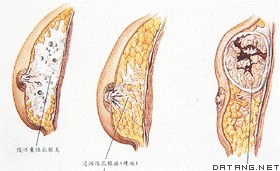1) anthracycline-resistant metastatic breast cancer


蒽环类耐药转移性乳腺癌
1.
Clinical oncologists should deliver chemotherapy based on evidence-based medicine and standardization for patients with anthracycline-resistant metastatic breast cancer,pay attention to individual treatment,and only this can make a new breakthrough in the treatment of patients with this disease.
肿瘤学工作者应以循证医学为指导,合理选择化疗方案,注重个体化治疗,才能在蒽环类耐药转移性乳腺癌的治疗上取得新突破。
2) Metastatic breast cancer


转移性乳腺癌
1.
Clinical study of the treatment of metastatic breast cancer by mainly paclitexal combined with chemotherapy.;
以紫杉醇为主的联合化疗方案治疗转移性乳腺癌的临床研究
2.
Clinical Analysis of a combination of Gemcitabine and Cisplatin on 51 Metastatic Breast Cancer Cases;
国产吉西他滨联合顺铂在转移性乳腺癌化疗的临床研究
3.
Regimen containing pirarubicin(THP) in treatment of metastatic breast cancer.;


含吡喃阿霉素方案治疗转移性乳腺癌
3) anthracycline-resistant


蒽环类耐药
1.
Paclitaxel and cisplatin in treatment of anthracycline-resistant advanced breast carcinoma;
紫杉醇联合顺铂治疗30例蒽环类耐药性晚期乳腺癌的疗效分析
2.
Objective To evaluate the efficacy and toxicity of vinorelbine(NVB) plus cisplatin(DDP) in the treatment of anthracycline-resistant advanced breast cancer.
目的观察长春瑞滨(vinorelbine,NVB)联合顺铂(cisplatin,DDP)组成的NP方案治疗蒽环类耐药晚期乳腺癌患者的疗效和毒副反应。
4) Breast cancer with lung metastasis/drug treatment


乳腺癌肺转移/药物疗法
5) breast cancer metastasis


乳腺癌转移
1.
Try hard to illuminating mechanism of MTA1、BRMS1 operating in breast cancer metastasis.


目的;通过研究MTA1、BRMS1在乳腺癌细胞中表达的相关性及与HDAC活性的关系,力图阐明MTA1、BRMS1在乳腺癌转移中的作用机制。
2.
In the previous study, our group has demonstrated that O-GlcNAc plays essencial roles in breast cancer metastasis; however, the underlying mechanism remains to be unclear.
本实验室的前期研究工作已经证明,O-GlcNAc促进小鼠乳腺癌4T1细胞的体外迁移和体内肺转移,但O-GlcNAc调节乳腺癌转移的分子机制还有待系统的研究。
3.
The correlation between TBX3 mRNA expression and the clinicopathologic parameters in relation to breast cancer metastasis was analyzed.
将这些总RNA逆转录成cDNA后,利用实时荧光定量PCR的方法检测TBX3基因在这些组织中的表达情况,分析其与乳腺癌转移相关的临床病理参数之间的关系。
6) BCRP


乳腺癌耐药蛋白
1.
Recently,researches are focussed on the MDR,including P-glycoprotein(Pgp),multidrug resistance-associated protein(MRP),lung resistance-asspcoated protein(LRP),topoisomerase II(TopoII)and breast cancer resistance protein(BCRP).
目前,P-糖蛋白(P-glycoprotein,Pgp)、多药耐药相关蛋白(multidrug resistance-associated protein,MRP)、肺耐药相关蛋白(lung re-sistance-associated protein,LRP)、拓扑异构酶II(topoisomeraseII,TopoII)及乳腺癌耐药蛋白(breast cancer resist-ance protein,BCRP),已成为人们研究的热点。
2.
Objective To explore the function of BCRP in ovary cancer and establisment of BCRP expressing ovary cancer cell line 3AO/BCRP.
目的探讨乳腺癌耐药蛋白(BCRP)在卵巢癌中的作用和逆转其介导的MDR,建立表达BCRP的耐药细胞系3AO/BCRP。
3.
Objective: To investigate the suppression of BCRP gene and protein by small interfering RNA (siRNA) and the restoration of sensitivity to chemotherapeutic drugs in multidrug-resistant hepatocellular carcinoma cell line HepG2/ADM.
目的:研究小片段RNA干扰对肝癌耐药细胞系HepG2/ADM中乳腺癌耐药蛋白(BCRP)基因及其产物表达的抑制作用和逆转其耐药性的效果。
补充资料:乳腺癌
| 乳腺癌 breast,cancer of 乳房的恶性肿瘤。发病率在中国占全身各种恶性肿瘤的7%~10%,在妇女仅次于宫颈癌。发病年龄以 40~60 岁居多数,其中又以45~49 岁(更年期)和 60~64 岁为最多。发病原因与性激素变化有很大关系。临床表现:最早的表现为患者侧乳房出现无痛 、单发的小肿块 ,质硬 ,表面 不光滑,与周围组织分界不很清楚,因此无自觉症状,常在洗澡、更衣时无意中发现。癌块增长的速度较快,随其体积增大,侵及周围组织后,在乳房内不易推动,进一步可引起乳房外形改变,如癌块表面皮肤凹陷、乳头牵向癌块方向、乳头内陷等,为重要乳腺癌体征。癌块继续增长,因皮内和皮下淋巴管被 癌 细胞 阻塞引起局 部淋巴水肿 ,故 表 面 皮肤呈暗红色。癌块发展至晚期可侵入胸肋膜、胸肌,以致癌块固定于胸壁而不易推动,并出现疼痛症状,有时皮肤破溃形成溃疡或呈菜花状。乳腺癌的转移途径为淋巴转移,晚期也可有血行转移,最初转移至腋窝淋巴结,先为散在,数目少,质硬无痛,可推动,以后数目增多,互相粘连成团,甚至与皮肤和深部组织粘连。按疾病严重程度分为 4 期:第一期,癌瘤完全局限于乳房内,其直径<3 厘米,无淋巴结转移 ;第二期,癌瘤< 5 厘米,同侧腋窝有数个散在而能推动的淋巴结;第三期,癌瘤直径 >5 厘米,同侧腋窝有一连串融合成块的淋巴结 ;第四期 ,癌瘤广泛扩散至皮肤 ,或与胸肌 、胸壁固定,广泛淋巴结转移或有远处转移 。乳腺癌的预后 :Ⅰ期5年治愈率90%左右,但此阶段应用现有的检查方法常常难以与乳房良性肿瘤区分,而活体组织切片检查则可以确诊。故强调开展普查,发现早期病例,或自己发现乳房有肿块时立即就诊。乳腺癌的治疗仍以早期手术治疗为主,辅以放射、激素、化学治疗等。
|
说明:补充资料仅用于学习参考,请勿用于其它任何用途。
参考词条
